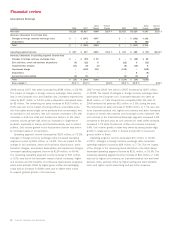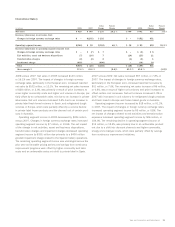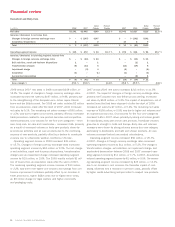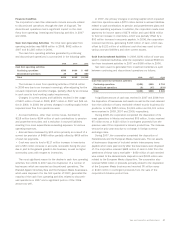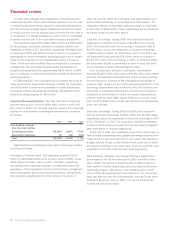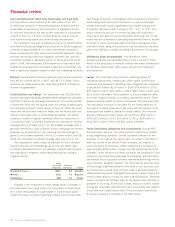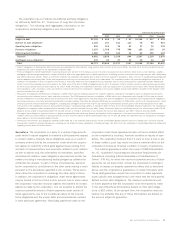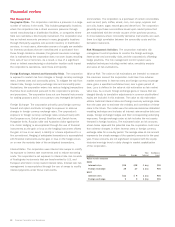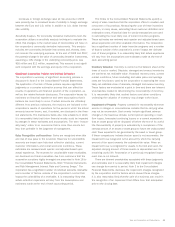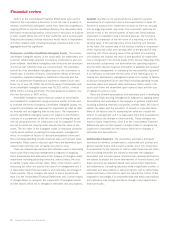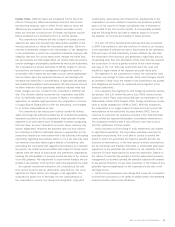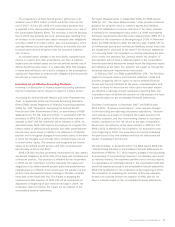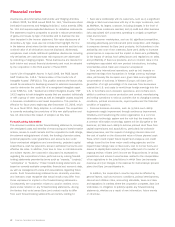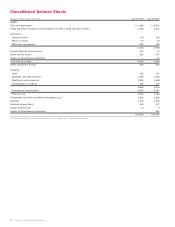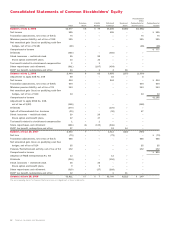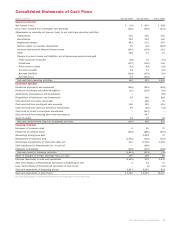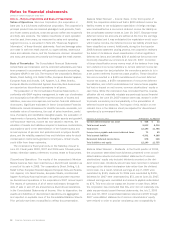Sara Lee 2008 Annual Report Download - page 36
Download and view the complete annual report
Please find page 36 of the 2008 Sara Lee annual report below. You can navigate through the pages in the report by either clicking on the pages listed below, or by using the keyword search tool below to find specific information within the annual report.Financial review
Note 5 to the Consolidated Financial Statements sets out the
impact of the corporation’s decisions to exit the use of property in
advance of previously anticipated useful lives. Given the corporation’s
ongoing efforts to improve operating efficiency, it is reasonably likely
that future restructuring actions could result in decisions to dispose
of other assets before the end of their useful life and it is reasonably
likely that the impact of these decisions would result in impairment
and other related costs including employee severance that in the
aggregate would be significant.
Trademarks and Other Identifiable Intangible Assets The primary
identifiable intangible assets of the corporation are trademarks and
customer relationships acquired in business combinations and com-
puter software. Identifiable intangibles with finite lives are amortized
and those with indefinite lives are not amortized. The estimated
useful life of an identifiable intangible asset to the corporation is
based upon a number of factors, including the effects of demand,
competition, expected changes in distribution channels and the
level of maintenance expenditures required to obtain future cash
flows. As of June 28, 2008, the net book value of trademarks and
other identifiable intangible assets was $1,021 million, of which
$926 million is being amortized. The anticipated amortization over
the next five years is $437 million.
Identifiable intangible assets that are subject to amortization
are evaluated for impairment using a process similar to that used
to evaluate elements of property. Identifiable intangible assets not
subject to amortization are assessed for impairment at least as often
as annually and as triggering events may occur. The impairment
test for identifiable intangible assets not subject to amortization
consists of a comparison of the fair value of the intangible asset
with its carrying amount. An impairment loss is recognized for the
amount by which the carrying value exceeds the fair value of the
asset. The fair value of the intangible asset is measured using the
royalty saved method. In making this assessment, management
relies on a number of factors to discount anticipated future cash
flows including operating results, business plans and present value
techniques. Rates used to discount cash flows are dependent upon
interest rates and the cost of capital at a point in time.
There are inherent assumptions and estimates used in developing
future cash flows requiring management’s judgment in applying
these assumptions and estimates to the analysis of intangible asset
impairment including projecting revenues, interest rates, the cost
of capital, royalty rates and tax rates. Many of the factors used in
assessing fair value are outside the control of management and it
is reasonably likely that assumptions and estimates will change in
future periods. These changes can result in future impairments.
Note 3 to the Consolidated Financial Statements sets out the impact
of charges taken to recognize the impairment of intangible assets
and the factors which led to changes in estimates and assumptions.
Goodwill Goodwill is not amortized but is subject to periodic
assessments of impairment and is discussed further in Note 15.
Goodwill is assessed for impairment at least as often as annually
and as triggering events may occur. The corporation performs its
annual review in the second quarter of each year. Recoverability
of goodwill is evaluated using a two-step process. The first step
involves a comparison of the fair value of a reporting unit with its
carrying value. If the carrying value of the reporting unit exceeds
its fair value, the second step of the process involves a comparison
of the implied fair value and carrying value of the goodwill of that
reporting unit. If the carrying value of the goodwill of a reporting
unit exceeds the implied fair value of that goodwill, an impairment
loss is recognized in an amount equal to the excess. Reporting units
are business components one level below the operating segment
level for which discrete financial information is available and reviewed
by segment management. In evaluating the recoverability of goodwill,
it is necessary to estimate the fair value of the reporting units. In
making this assessment, management relies on a number of factors
to discount anticipated future cash flows including operating results,
business plans and present value techniques. Rates used to dis-
count cash flows are dependent upon interest rates and the cost
of capital at a point in time.
There are inherent assumptions and estimates used in developing
future cash flows requiring management’s judgment in applying these
assumptions and estimates to the analysis of goodwill impairment
including projecting revenues and profits, interest rates, the cost of
capital, tax rates, and the allocation of shared or corporate items.
Many of the factors used in assessing fair value are outside the
control of management and it is reasonably likely that assumptions
and estimates can change in future periods. These changes can
result in future impairments. Note 3 to the Consolidated Financial
Statements sets out the impact of charges taken to recognize the
impairment of goodwill and the factors which led to changes in
estimates and assumptions.
Self-Insurance Reserves The corporation purchases third-party
insurance for workers’ compensation, automobile and product and
general liability claims that exceed a certain level. The corporation
is responsible for the payment of claims under these insured limits,
and consulting actuaries are utilized to estimate the obligation
associated with incurred losses. Historical loss development factors
are utilized to project the future development of incurred losses, and
these amounts are adjusted based upon actual claim experience
and settlements. Consulting actuaries make a significant number of
estimates and assumptions in determining the cost to settle these
claims and many of the factors used are outside the control of the
corporation. Accordingly, it is reasonably likely that these assumptions
and estimates may change and these changes may impact future
financial results.
34 Sara Lee Corporation and Subsidiaries


